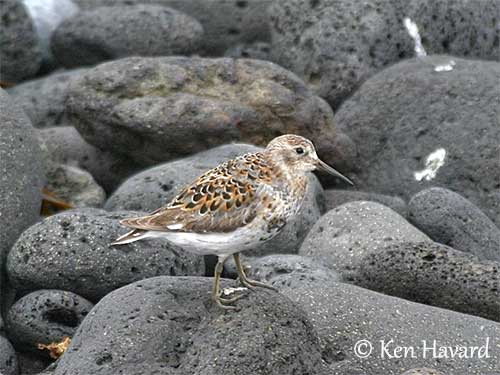
PROTECTION / THREATS / STATUS:
The Rock Sandpiper has large range but the population trend is decreasing. The global population was estimated to number 160,000/170,000 individuals in 2006.
But the species is not globally threatened, and the Rock Sandpiper is currently evaluated as Least Concern.
Fr: Bécasseau des Aléoutiennes
Ang: Rock Sandpiper
All: Beringstrandläufer
Esp: Correlimos Roquero
Ita: Piovanello di roccia
Nd: Beringstrandloper
Sd: klippsnäppa
Photographers:
John Anderson
John Anderson Photo Galleries
Ken Havard
My Bird Gallery & Flickr gallery 1 & Flickr gallery 2
Tom Merigan
Tom Merigan’s Photo Galleries
Otto Plantema
Trips around the world
William Price
PBase-tereksandpiper & Flickr William Price
Text by Nicole Bouglouan
Sources:
HANDBOOK OF THE BIRDS OF THE WORLD Vol 3 by Josep del Hoyo-Andrew Elliott-Jordi Sargatal - Lynx Edicions - ISBN: 8487334202
SHOREBIRDS by Peter Hayman, John Marchant and Tony Prater – Christopher Helm – 1986 – ISBN: 0747014035
GUIDE DES LIMICOLES de D. Taylor - Delachaux et Niestlé - ISBN : 2603014080
FIELD GUIDE TO THE BIRDS OF NORTH AMERICA - National Geographic Society - ISBN: 0792274512
All About Birds (Cornell Lab of Ornithology)
The Birds of North America online
What Bird-The ultimate Bird Guide (Mitchell Waite)
Bird Web (Seattle Audubon Society)
Wikipedia, the free encyclopaedia
Rock Sandpiper
Calidris ptilocnemis
Charadriiformes Order – Scolopacidae Family
INTRODUCTION:
The Rock Sandpiper is a medium-sized sandpiper of genus Calidris found in the N Pacific. As indicated by its name, this species is typically found on rocky coasts, especially outside breeding season, but it breeds in upland tundra in coastal regions.
Four subspecies share the range in extreme NE Siberia and W Alaska where they breed. They spend the winter in E Japan and on NW coasts of North America to N California.
The Rock Sandpiper is not globally threatened, but the population is suspected to be decreasing since the 1970s in NW America.

DESCRIPTION OF THE BIRD:
Biometrics:
Length: 20-23 cm
Wingspan: 36-39 cm
Weight: 80-135 g
The Rock Sandpiper is very similar to the Purple Sandpiper of which it is the Pacific counterpart.
The adult male in breeding plumage has blackish-brown mantle, scapulars and tertials, with deep chestnut and pale buff fringes. On the upperwing, the wing-coverts are brownish-grey to grey with white edges. The flight-feathers are blackish. A pale wingbar is formed by the broad white fringes to the outer webs of the inner primaries, the white tips to the greater coverts and the white outer webs of secondaries. This wingbar is mainly visible in flight. Rump and uppertail-coverts are mostly blackish with white sides. The tail is dark.
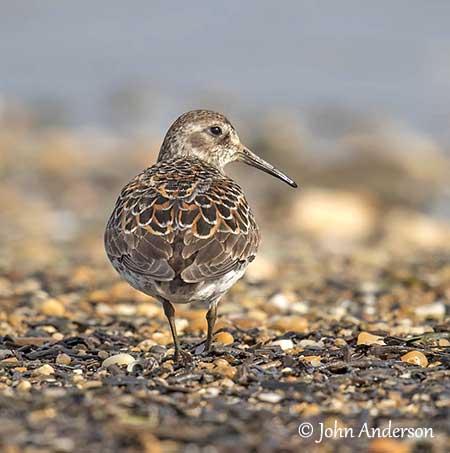
On the underparts, the chin is whitish whereas the upper breast is buffish and variably streaked brown. The lower breast shows large dark spots, often forming a blackish patch. Belly and flanks are white with some brown streaking.
On the head, the crown is brownish-black with chestnut edges. The supercilium is whitish and may sometimes meet on the forehead. Lores and rear ear-coverts show dark patches. Head sides are whitish with some darker streaks.
The long, slender bill is blackish and slightly down-curved. Its base is greenish-yellow. The eyes are dark brown. Legs and feet are greenish-yellow.
The female has similar plumage but she is slightly larger with longer bill than male.
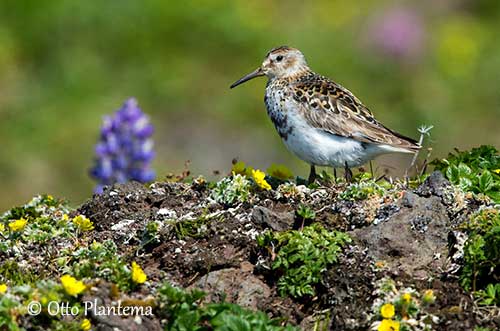
The adult in winter has mainly grey upperparts. The breast is pale grey while rest of underparts is mainly white.
The crown is pale brownish-grey with white fringes. The pale forehead often joins the short supercilium.
The juvenile has buff foreneck and breast with narrow brown streaks. The underparts are white with slightly streaked flanks. The upperpart feathers have dark centres and pale chestnut and buff fringes. The wing-coverts are grey-brown with broad buff fringes.
SUBSPECIES AND RANGE:
The Rock Sandpiper has four subspecies:
C.p. quarta breeds in S Kamchatka, on Commander Is and probably Kuril Is too. It winters S to E Japan.
C.p. tschuktschorum breeds in E Chukotsky Peninsula, St Lawrence Is, Nunivak I and W Alaska. It winters on coasts of NW North America S to N California, and locally in E Japan.
C.p. ptilocnemis (described above) breeds on islands in E Bering Sea (St Matthew I, Hall I and Pribilof Is). It winters on S Alaska Peninsula E to Alexander Archipelago.
C.p. couesi breeds in Aleutian Is and Alaska Peninsula, including Shumagin Is and Kodiak I. It winters throughout the same areas.
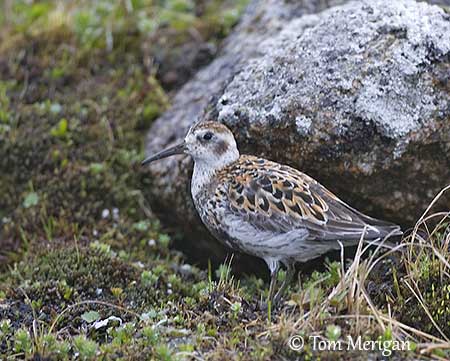
The race “tschuktschorum” resembles nominate. The other races are fairly similar to the Purple Sandpiper but with darker chestnut fringes above. Broad dark streaks below form a blackish patch on breast, extending sometimes to belly. The white wingbar is more conspicuous.
HABITAT:
The Rock Sandpiper breeds in dry, barren tundra with sparse vegetation such as lichen, moss and grasses, usually in coastal regions. Outside breeding season, it can be seen on rocky shores and rock jetties. It forages below the tide line on mounds of algae.
CALLS AND SONGS: SOUNDS BY XENO-CANTO
The Rock Sandpiper is usually silent, but some low whistles can be heard in winter, and short hoarse or raspy calls.
But during the breeding season, it performs aerial displays accompanied by a series of “grrwee…grrwee…grrwee…” faster than calls of the Purple Sandpiper. We can also hear slower series of gruff burry notes and other variants. Other calls include a short “chuck” and an upslurred “chweet”.
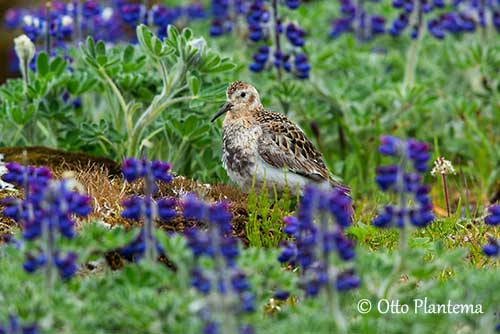
BEHAVIOUR IN THE WILD:
The Rock Sandpiper on the breeding grounds feeds mainly on insects, but it also consumes molluscs, crustaceans and marine worms. It may also eat berries, seeds, moss and algae, unlike other sandpiper species.
During winter and on migration, it feeds mainly on molluscs, crustaceans and insects.
It forages by walking slowly on mats of algae, picking prey with the bill. It may feed in the water, up to the breast, and swims very well. In some areas, especially Pribilof Islands, it also probes in mudflats and sandy areas, and also forages on tundra. They may form large foraging flocks on their wintering grounds.
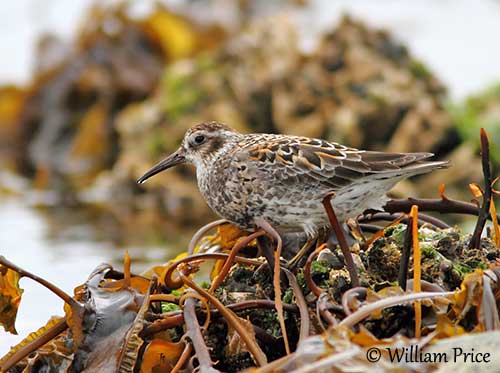
At the beginning of the breeding season, the male defends the territory by performing aerial displays. It flies in wide circle with fluttering wingbeats while uttering trilled calls. On the ground, aggressive displays show the male raising one wing vertically.
They are monogamous and often have long-term pair-bonds. They usually return to the same nesting sites, and nest at densities of up to 12 pairs/km².
The Rock Sandpiper is partly migratory. The nesting populations on Pribilofs and Aleutians only perform short-distances movements or are permanent residents. The mainland breeding populations move farther south. They return to the breeding grounds from mid-April.
The flight is swift with shallow, clipped wingbeats.
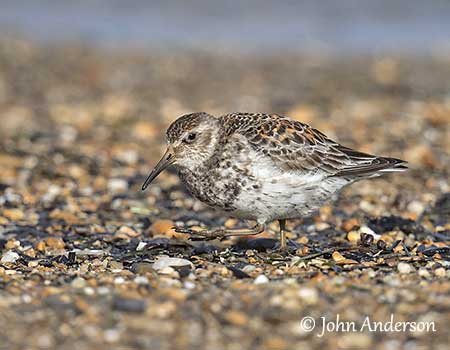
REPRODUCTION OF THIS SPECIES:
The laying occurs from early May to early June. The nest is on the ground in the open, dry tundra, often on raised area with lichen and moss. The scrape is made by the male and the female adds lichens, grass or leaves.
The female lays four olive to buff eggs with brown markings. Both adults share the incubation during about 20 days. The adults perform distraction displays if the nest is threatened by predators such as Arctic foxes or others.
The chicks leave the nest very soon after hatching and are able to feed themselves. They are tended by the male, more rarely by the female or both parents. They probably fledge three weeks after hatching.
